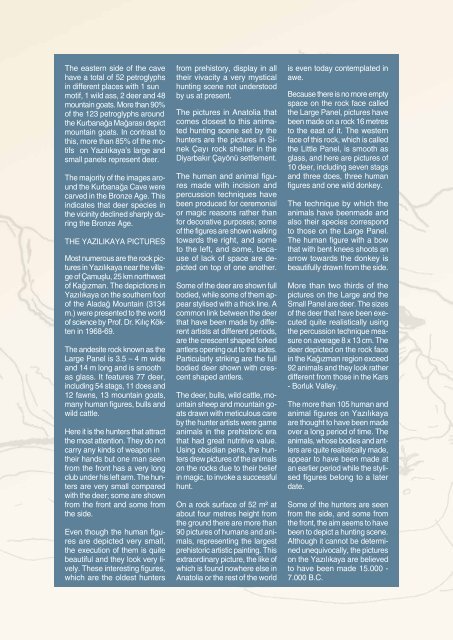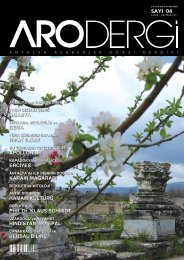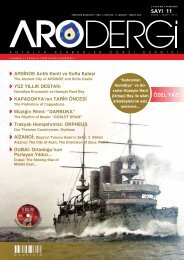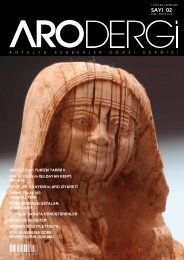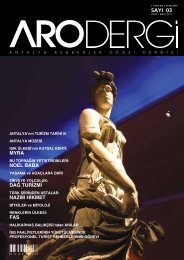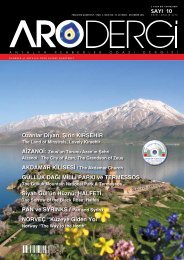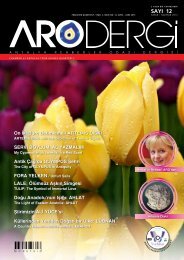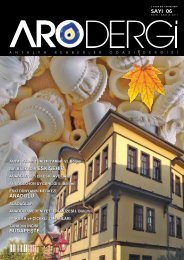Sayı 07- Ocak / Mart 2012 - Antalya Rehberler Odası
Sayı 07- Ocak / Mart 2012 - Antalya Rehberler Odası
Sayı 07- Ocak / Mart 2012 - Antalya Rehberler Odası
Create successful ePaper yourself
Turn your PDF publications into a flip-book with our unique Google optimized e-Paper software.
The eastern side of the cave<br />
have a total of 52 petroglyphs<br />
in different places with 1 sun<br />
motif, 1 wild ass, 2 deer and 48<br />
mountain goats. More than 90%<br />
of the 123 petroglyphs around<br />
the Kurbanağa Mağarası depict<br />
mountain goats. In contrast to<br />
this, more than 85% of the motifs<br />
on Yazılıkaya’s large and<br />
small panels represent deer.<br />
The majority of the images around<br />
the Kurbanağa Cave were<br />
carved in the Bronze Age. This<br />
indicates that deer species in<br />
the vicinity declined sharply during<br />
the Bronze Age.<br />
THE YAZILIKAYA PICTURES<br />
Most numerous are the rock pictures<br />
in Yazılıkaya near the village<br />
of Çamuşlu, 25 km northwest<br />
of Kağızman. The depictions in<br />
Yazılıkaya on the southern foot<br />
of the Aladağ Mountain (3134<br />
m.) were presented to the world<br />
of science by Prof. Dr. Kılıç Kökten<br />
in 1968-69.<br />
The andesite rock known as the<br />
Large Panel is 3.5 – 4 m wide<br />
and 14 m long and is smooth<br />
as glass. It features 77 deer,<br />
including 54 stags, 11 does and<br />
12 fawns, 13 mountain goats,<br />
many human figures, bulls and<br />
wild cattle.<br />
Here it is the hunters that attract<br />
the most attention. They do not<br />
carry any kinds of weapon in<br />
their hands but one man seen<br />
from the front has a very long<br />
club under his left arm. The hunters<br />
are very small compared<br />
with the deer; some are shown<br />
from the front and some from<br />
the side.<br />
Even though the human figures<br />
are depicted very small,<br />
the execution of them is quite<br />
beautiful and they look very lively.<br />
These interesting figures,<br />
which are the oldest hunters<br />
from prehistory, display in all<br />
their vivacity a very mystical<br />
hunting scene not understood<br />
by us at present.<br />
The pictures in Anatolia that<br />
comes closest to this animated<br />
hunting scene set by the<br />
hunters are the pictures in Sinek<br />
Çayı rock shelter in the<br />
Diyarbakır Çayönü settlement.<br />
The human and animal figures<br />
made with incision and<br />
percussion techniques have<br />
been produced for ceremonial<br />
or magic reasons rather than<br />
for decorative purposes; some<br />
of the figures are shown walking<br />
towards the right, and some<br />
to the left, and some, because<br />
of lack of space are depicted<br />
on top of one another.<br />
Some of the deer are shown full<br />
bodied, while some of them appear<br />
stylised with a thick line. A<br />
common link between the deer<br />
that have been made by different<br />
artists at different periods,<br />
are the crescent shaped forked<br />
antlers opening out to the sides.<br />
Particularly striking are the full<br />
bodied deer shown with crescent<br />
shaped antlers.<br />
The deer, bulls, wild cattle, mountain<br />
sheep and mountain goats<br />
drawn with meticulous care<br />
by the hunter artists were game<br />
animals in the prehistoric era<br />
that had great nutritive value.<br />
Using obsidian pens, the hunters<br />
drew pictures of the animals<br />
on the rocks due to their belief<br />
in magic, to invoke a successful<br />
hunt.<br />
On a rock surface of 52 m² at<br />
about four metres height from<br />
the ground there are more than<br />
90 pictures of humans and animals,<br />
representing the largest<br />
prehistoric artistic painting. This<br />
extraordinary picture, the like of<br />
which is found nowhere else in<br />
Anatolia or the rest of the world<br />
is even today contemplated in<br />
awe.<br />
Because there is no more empty<br />
space on the rock face called<br />
the Large Panel, pictures have<br />
been made on a rock 16 metres<br />
to the east of it. The western<br />
face of this rock, which is called<br />
the Little Panel, is smooth as<br />
glass, and here are pictures of<br />
10 deer, including seven stags<br />
and three does, three human<br />
figures and one wild donkey.<br />
The technique by which the<br />
animals have beenmade and<br />
also their species correspond<br />
to those on the Large Panel.<br />
The human figure with a bow<br />
that with bent knees shoots an<br />
arrow towards the donkey is<br />
beautifully drawn from the side.<br />
More than two thirds of the<br />
pictures on the Large and the<br />
Small Panel are deer. The sizes<br />
of the deer that have been executed<br />
quite realistically using<br />
the percussion technique measure<br />
on average 8 x 13 cm. The<br />
deer depicted on the rock face<br />
in the Kağızman region exceed<br />
92 animals and they look rather<br />
different from those in the Kars<br />
- Borluk Valley.<br />
The more than 105 human and<br />
animal figures on Yazılıkaya<br />
are thought to have been made<br />
over a long period of time. The<br />
animals, whose bodies and antlers<br />
are quite realistically made,<br />
appear to have been made at<br />
an earlier period while the stylised<br />
figures belong to a later<br />
date.<br />
Some of the hunters are seen<br />
from the side, and some from<br />
the front, the aim seems to have<br />
been to depict a hunting scene.<br />
Although it cannot be determined<br />
unequivocally, the pictures<br />
on the Yazılıkaya are believed<br />
to have been made 15.000 -<br />
7.000 B.C.


